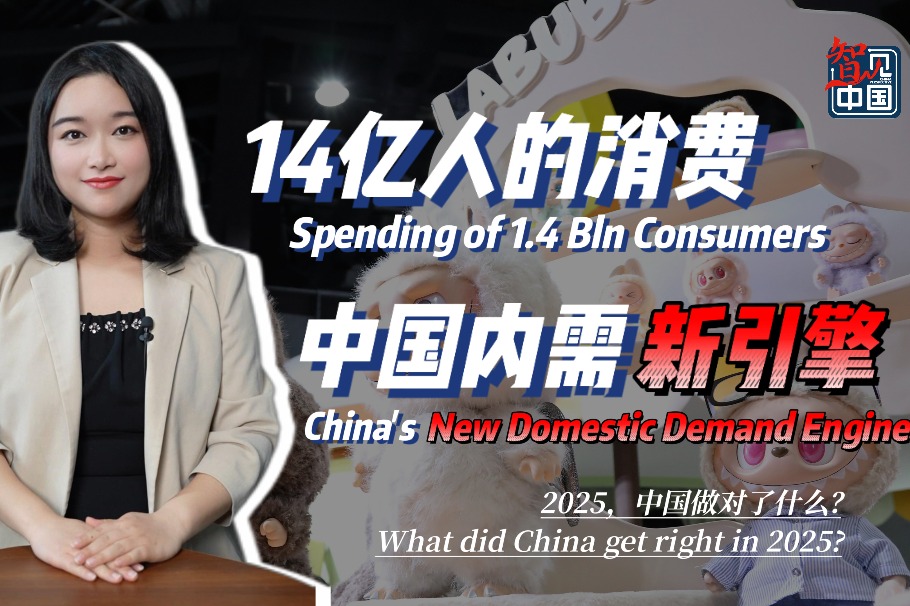Keys to achieving China's annual economic growth target of 5%
Expansionary fiscal and monetary policies needed to alleviate deflationary pressures
By Yu Yongding | China Daily | Updated: 2024-09-23 09:23

To assess whether we can reach the annual economic growth target, we first need a reasonable analytical framework. Using the simplest expenditure method to analyze the possibility of achieving around 5 percent GDP growth in 2024, we must consider the three main components of economic growth: final consumption, capital formation, and net exports. We also need to make reasonable assumptions about the growth rates of these components.
In 2023, China's final consumption grew by about 8 percent, contributing 82 percent to the 5.2 percent GDP growth. This high consumption growth was mainly due to the base effect. Assuming that consumption growth will drop to around 5 percent in 2024 and that the trade surplus holds flat, we can conclude that to achieve around 5 percent annual GDP growth, the required growth rate for capital formation should hit 5.3 percent, higher than the 3.5 percent growth in 2023.
During the January-April period, China's retail sales, a key measurement of consumer spending, grew by 4.1 percent year-on-year. This indicates that to reach the annual growth target, capital formation growth in 2024 will need to exceed the initially set 5.3 percent.
The growth in property investment in the first half of the year was weaker than expected. However, the manufacturing sector exceeded expectations due to the rapid growth of industries like new energy vehicles. In the first quarter, manufacturing investment growth reached 9.9 percent, somewhat offsetting the negative impacts of low consumption growth and the declining real estate sector on GDP growth. Nonetheless, it is clear that infrastructure investment growth in the second half of the year should be significantly higher than initially assumed. Only then can China likely achieve its annual GDP growth target for the year.
For a long time, China's producer price index, which gauges factory-gate prices, has registered negative growth. Meanwhile, the growth of China's consumer price index, the main gauge of inflation, has fluctuated around 2 percent, even experiencing negative growth at times. In this context, it is necessary to implement expansionary fiscal and monetary policies to stimulate economic growth and alleviate deflationary pressures.
In light of weak expectations and a lack of willingness to invest among enterprises, we must increase infrastructure investment. It is crucial to emphasize that we refer to a broad definition of infrastructure, which includes areas like "new infrastructure", healthcare, elderly housing, cultural education facilities, and R&D — investments that typically lack profits and are unlikely to attract private enterprises.
I fully agree with the view that the fundamental reason for current low price levels lies in insufficient demand and supply-demand imbalances, rather than inadequate monetary supply. The main issue is the inadequate total demand. Although some policies aimed at stimulating consumption and the real estate market were introduced in the first half of the year, their effects have not been significant, possibly due to late implementation or insufficient intensity to effectively address current economic challenges. Therefore, the government needs to continue to strengthen expansionary macroeconomic policies, particularly fiscal policies, while ensuring these policies are effectively implemented.
If the expansionary policies prove effective and China successfully achieves the around 5 percent annual growth target this year, we can maintain economic growth above 5 percent by 2025. However, we cannot rule out the possibility of external shocks or policy missteps leading to a sudden rise in inflation before achieving potential growth rates. Thus, we must seize the current opportunity and strive to reach the around 5 percent annual economic growth target.
When it comes to the question of whether capital formation growth in 2024 can exceed that of 2023, it depends on whether infrastructure growth can significantly surpass that of 2023. Infrastructure investment growth is influenced by several factors, including project reserves, local government incentives, and the availability of funds and costs.
In the first half of the year, the government's issuance actions of ultra-long-term special treasury bonds were relatively slow, possibly due to concerns about the potential crowding-out effects and market volatility from excessive bond issuance, or due to inflation fears.
With further issuance of treasury bonds, the People's Bank of China, the country's central bank, is expected to intensify open market operations. The central bank should coordinate with the Ministry of Finance to increase bond purchases to mitigate the "crowding-out effect", lower interest rates, and stimulate economic growth.
When it comes to the question of "how to solve China's high savings rate problem", China currently needs to focus on increasing total demand rather than on the high savings rates. Increasing total demand essentially means boosting consumption, investment, and net export demand. Supporting exports is necessary in the current context, but relying on exports for economic growth is not sustainable. Local governments should avoid stimulating exports through measures like tax rebates and instead focus on helping enterprises transform and upgrade while exploring domestic markets. Stimulating consumption is also essential, with localized strategies based on actual conditions. In the medium to long term, the government should work on reforms in the tax system and social security to increase income equality and enhance overall consumption propensity.
While China's savings rate is relatively high, several countries, especially in Asia and Northern Europe, have savings rates comparable to or higher than China's, such as Singapore. As long as high savings are voluntary rather than forced, they are not necessarily a bad thing. The government should focus on transforming savings into investments rather than simply lowering the savings rate.
In the current situation, since consumption is a function of income, income expectations, and wealth, residents will not increase consumption without growth in income, improvement in income expectations, or rising asset prices. Even if the government provides residents with cash, they are likely to save it for emergencies. Therefore, the government should concentrate on using controllable methods, such as infrastructure investment, to kick-start economic growth. Infrastructure investment not only directly creates demand, but also generates a "crowding-in effect", stimulating investment in other sectors and promoting overall economic growth. As the economy grows, residents' incomes will rise, leading to increased consumer spending.
In 2024, the government should aggressively issue treasury bonds to support infrastructure investment, ensuring that we can smoothly achieve around 5 percent economic growth in 2025.
The economic outlook for the second half of 2024 remains challenging, but we still have a time window to realize the annual growth target. Currently, inflation remains at historically low levels, allowing plenty of room for implementing expansionary fiscal and monetary policies. In contrast, the US faces greater economic pressure, balancing inflation, growth, and international payments. China, however, only needs to focus on economic growth.
Overall, I believe that the economic situation in the US has limited impact on China. The key is for us to manage our own affairs well. As 2024 is already more than halfway through, adopting a wait-and-see approach is not advisable. We must adopt a resolute spirit to achieve the around 5 percent annual economic growth target and reverse the declining trend in economic growth that has persisted since 2010.
The writer is a member of the Academic Divisions of the Chinese Academy of Social Sciences.
The views do not necessarily reflect those of China Daily.
























